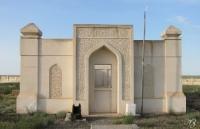Вы здесь
Ainazar ata necropolis.

Take an excursion in Aktau and Mangyshlak.
“Around Mangyshlak there are burials of saints revered by the Kazakhs and Turkmen. A pole was erected on each of them. Hunters, according to custom, carry the gift of killed argali heads. The same rite is performed with camels, horses, faithfully served to their masters. The pole is the symbol of the right word. The oath taken at the tomb of the saint is considered proof of the defendant’s innocence, which is not decided by everyone. Swears should clasp the pole with both hands and say: “I have not seen, I have not heard, I have not drunk, I have not eaten. If I say a lie, may God kill me, may this holy one kill ”
"Notes of the Imperial Russian Geographical Society". XIX century.
Packaged tour Atyrau to Mangyshlak.
Not far from Fort Shevchenko on Mangistau, along the road, the necropolis of Ainazar ata is located (XVIII - XIX centuries). At the entrance to the necropolis is a small sanctuary - a stone hill with a wooden pole. In the Notes of the Imperial Russian Geographical Society (XIX century), written by Russian researchers of the Eastern Caspian Sea, there is the following:
“The graves of saints, revered by the Kazakhs and Turkmen, are located throughout Mangyshlak. A pole was erected on each of them. Hunters, according to custom, carry the gift of killed argali heads. The same rite is performed with camels, horses, faithfully served to their masters.
The pole is the symbol of the right word. The oath taken at the tomb of the saint is considered proof of the defendant’s innocence, which is not decided by everyone. The oath-taker should clasp the pole with both hands and say:
“I have not seen, I have not heard, I have not drunk, I have not eaten. If I tell a lie, may God kill me, may this holy one kill. ” Stone structures with domes and inscriptions from the Koran were erected over some graves. All the wandering shepherds nearby gather to the built mosques for prayer.
The sanctuary is surrounded by an old fence, as well as a modern stone fence. There is a small house for pilgrims, where you can drink fragrant hot tea and enjoy delicious beshbarmak. In the old part of the necropolis there are vertical slabs of coarse processing, Coitas, and traditional shaped Saganatams.
The necropolis bears the name of Batyr Ainazar (1786 - 1870). The people praised Ainazar ata for courage and bravery. There are legends about the batyr in the people that he killed four dragons that bring fear to the villagers.
What kind of dragons lived in the vicinity of Tupkaragan is unknown. One thing we know that the batyr first rose to protect the interests of his people. And in battles he was distinguished by his accuracy and heroism.
Ainazar ata was an active participant in the Adaev revolt of 1870. Batyr was killed in one of the battles during the suppression of the uprising by soldiers of the Russian Tsarist Army. In 1995, at the burial site of Ainazar ata, fellow countrymen and relatives found white limestone shell stone Saganatam.
Authority and photos:
Natalia Zaderetskaya "Tupkaragan - the cradle of Mangystau." http://mangystau.info







